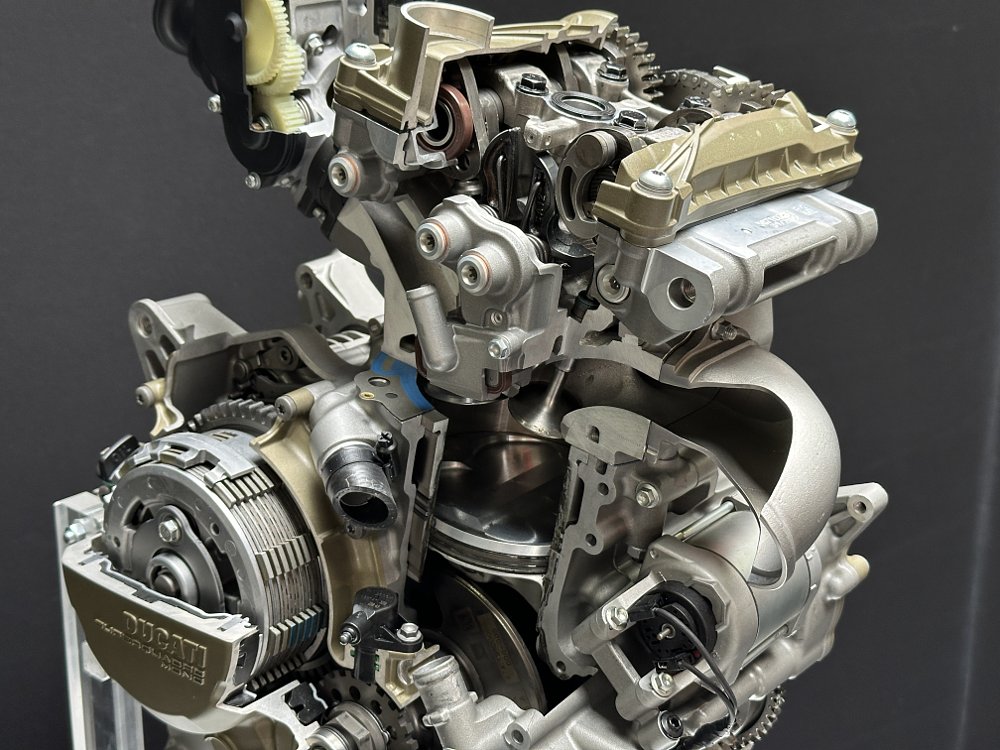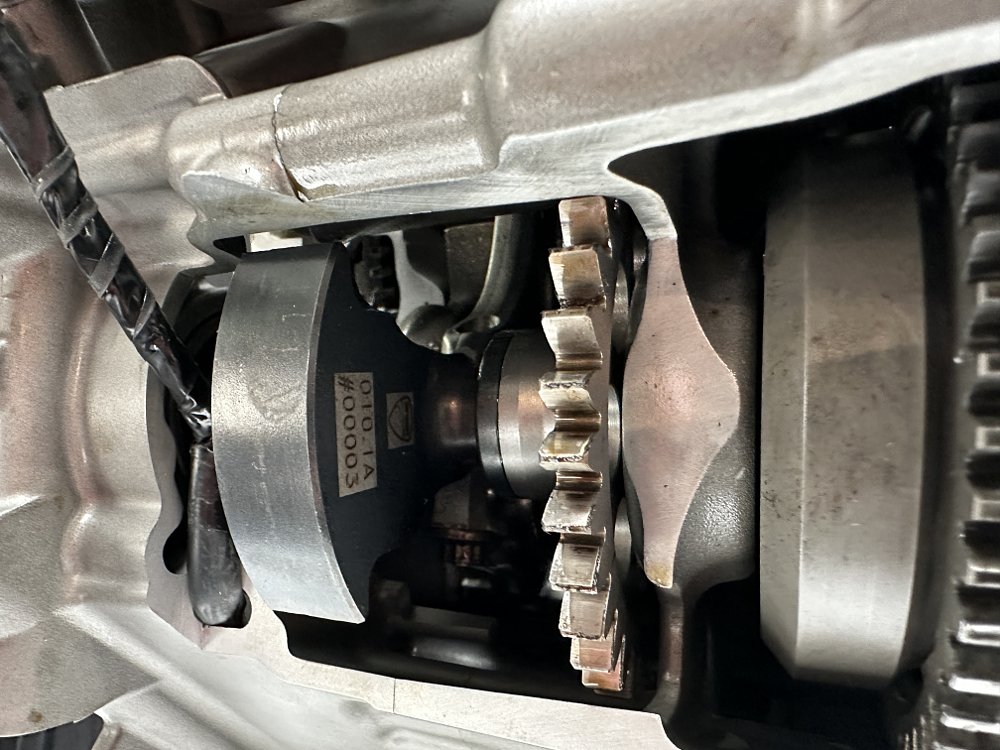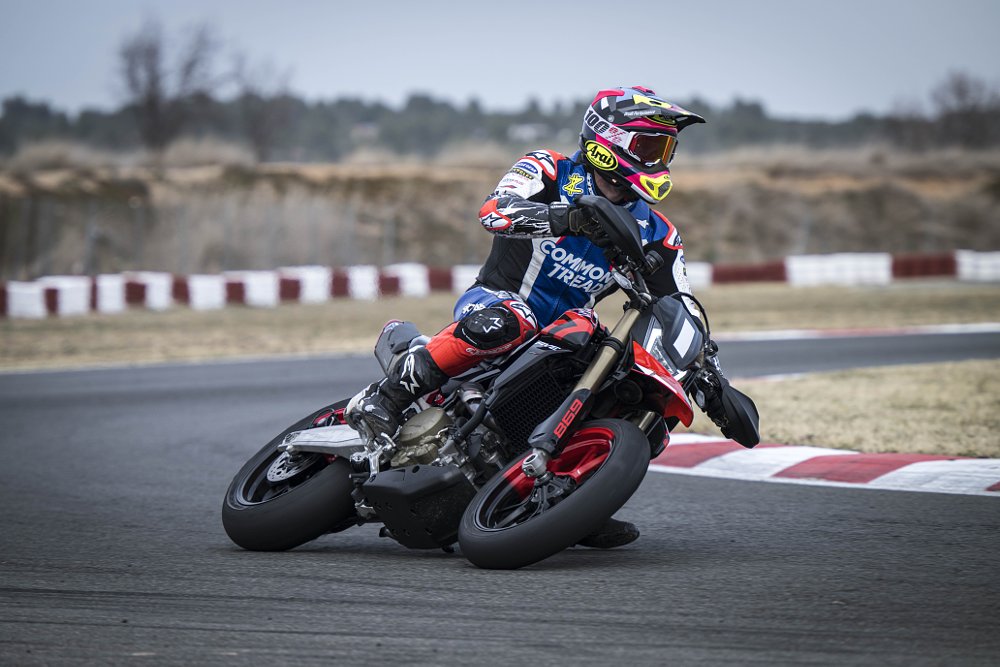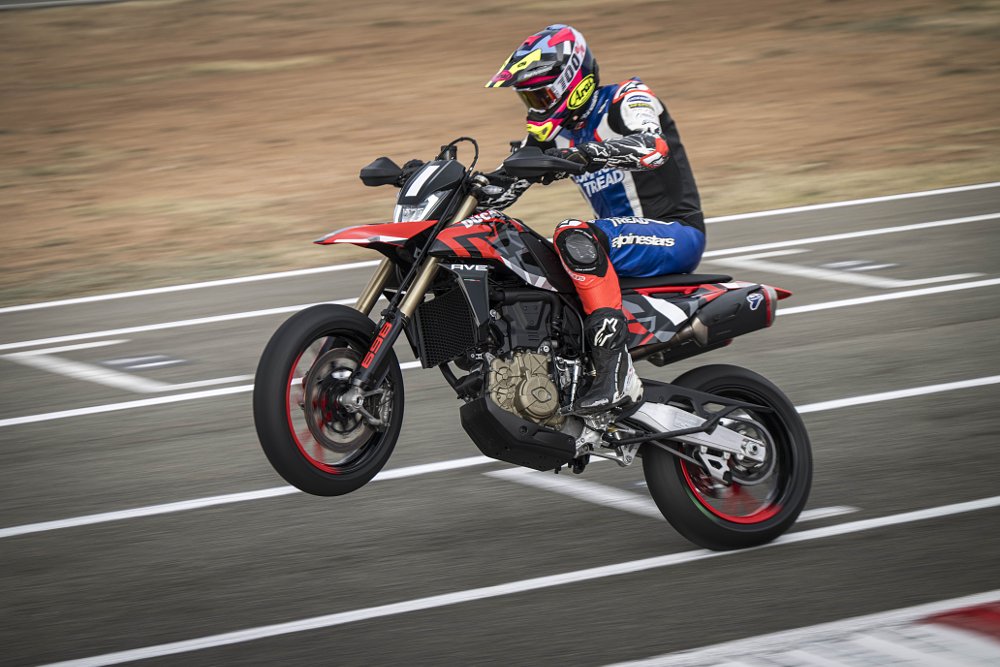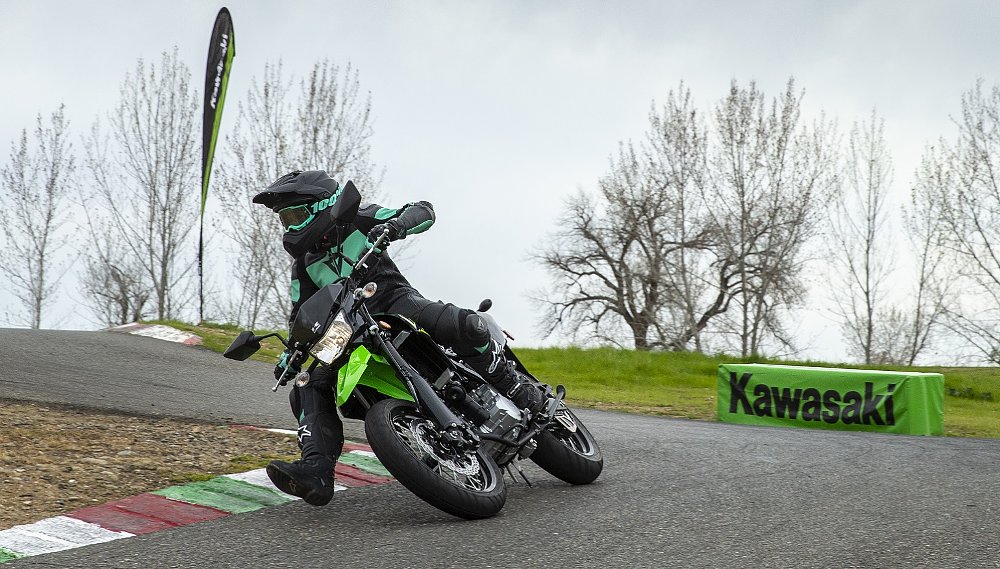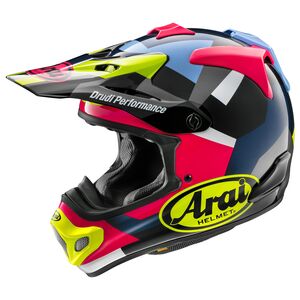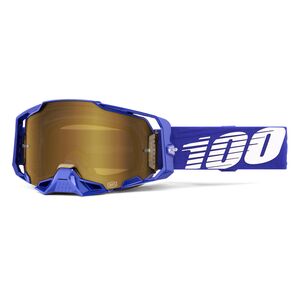In the world of motorcycling, nothing is as simple as a single-cylinder machine. Usually.
This new single from Ducati isn’t one of those bikes. A new engine and new platform for the company, with a wholly different approach to safety features, and all of it is aimed at a new target market. That’s a lot of complexity to pack into the lightest bike Ducati has made in recent history.
Hyper tech and motard design
As Dustin explained in the first look at the Hyper 698, the engine is practically a 1299 Panigale powerplant with the front cylinder chopped off and a slightly longer stroke in the remaining sleeve — same piston, same pieces in the desmodromic valvetrain, and the same valves. It’s a neat idea, and according to Ducati it’s one that was born from “the passion of the company, not the business side.”
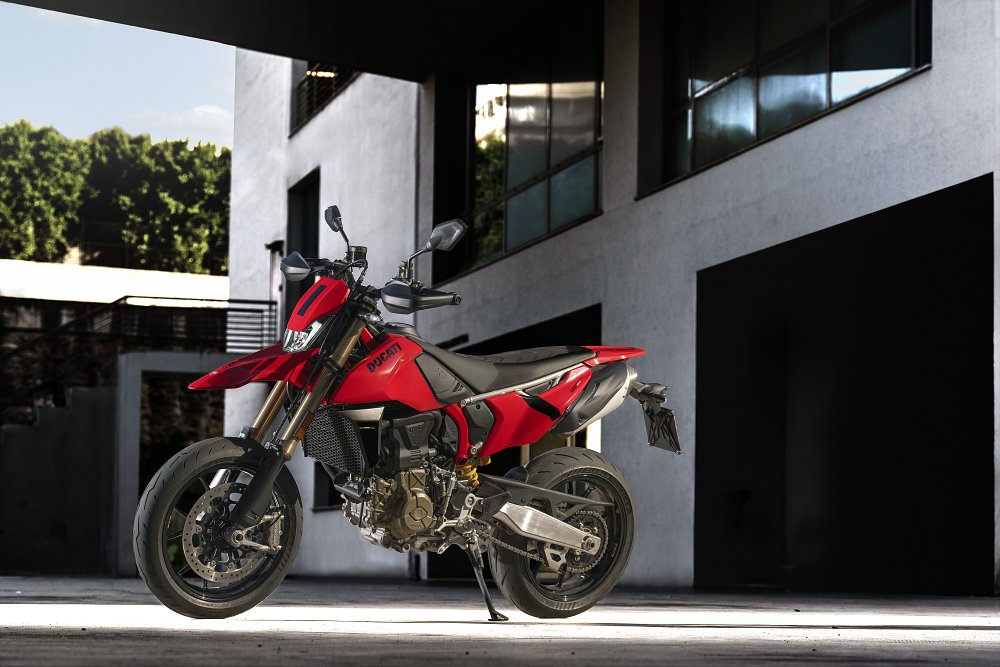
Whether it was passion or business, all of the engineers and staff were quick to point out the many measures taken to keep the engine light, only 98.3 pounds, they said. There are magnesium case covers, an aluminum cylinder, and the two counterbalancers in the crankcase spin on the same shafts as the water pump and the oil-scavenge pump. Tidy. This mantra continues to the rest of the bike, with a standard lithium-ion battery and cast wheels (rather than wire-spoke), all of which saves a handful of pounds.
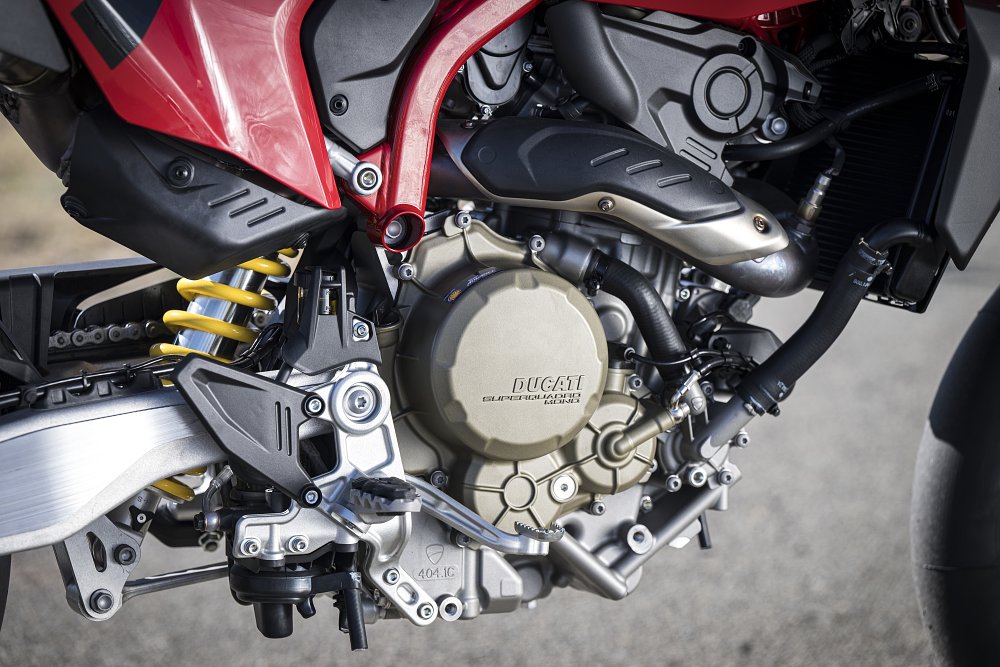
Fortunately for Ducati, all of the lines of code that went into the suite of rider aids don’t weigh anything, because there are a lot of them. Traction control, wheelie control, engine braking, ABS settings, and throttle maps can all be adjusted within four different ride-mode silos; Sport, Road, Urban, and Wet.
On the topic of saving weight, the Hyper 698’s dash doesn’t waste much space. A 3.8-inch LCD with most information displayed in two colors, including all of the menus to view and adjust the load of settings discussed above, as well as the usual ride data and info.
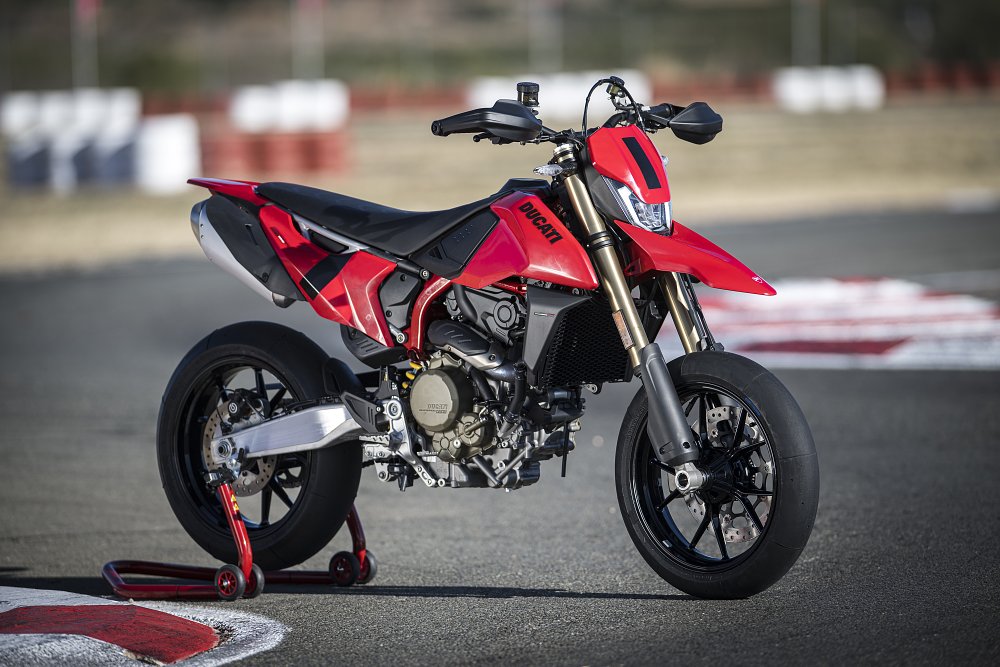
And then there are those hip and bushy tailed 20-something urbanites that Ducati would like to attract with the Hypermotard 698. I was told this machine is “very strategic for Ducati” because it represents a new entry point into the company, even with an MSRP of $12,995. Along with being the first single-cylinder street bike produced in decades, it is modern and sophisticated, not retro, meaning it ought to bring in fresh customers. Ducati has been developing this new bike, aiming at that target, for four years.
Riding around a go-kart track
But the Bolognese can’t help themselves. Instead of introducing this machine to the world’s motorcycling press with street art, or a TikTok workshop, or some other thing that represents youth, we gathered at the Kartodromo Lucas Guerrero a few miles west of Valencia, Spain for an old-school supermoto performance test.
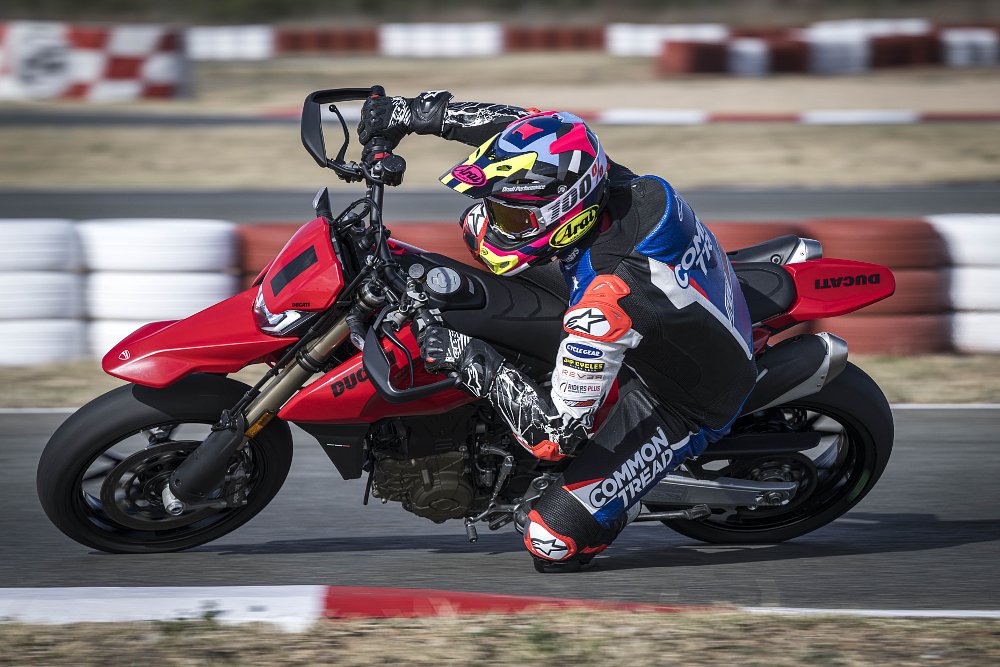
Initial impressions of the Hyper 698 is that it’s tall, just like the 35.6-inch seat height suggests, and fairly plush. Unlike a true supermotard machine, the Hyper 698 has zero off-road DNA or pedigree, and yet it feels surprisingly like a dirt bike. The seat is flat and firm, not cushy but wider and more pleasantly shaped than an actual off-roader, and immediately offered the flexibility to sit just behind the handlebar or a foot-and-a-half farther back.
The suspension is soft, too. It doesn’t feel unbalanced, there’s just bound to be some sag when my 200 pounds sit on a bike with 8.5 inches of travel in the fork and 9.4 inches in the shock. At first startup, the engine seems peppy and is quick to rev, just what you’d expect from the super short-stroke design.
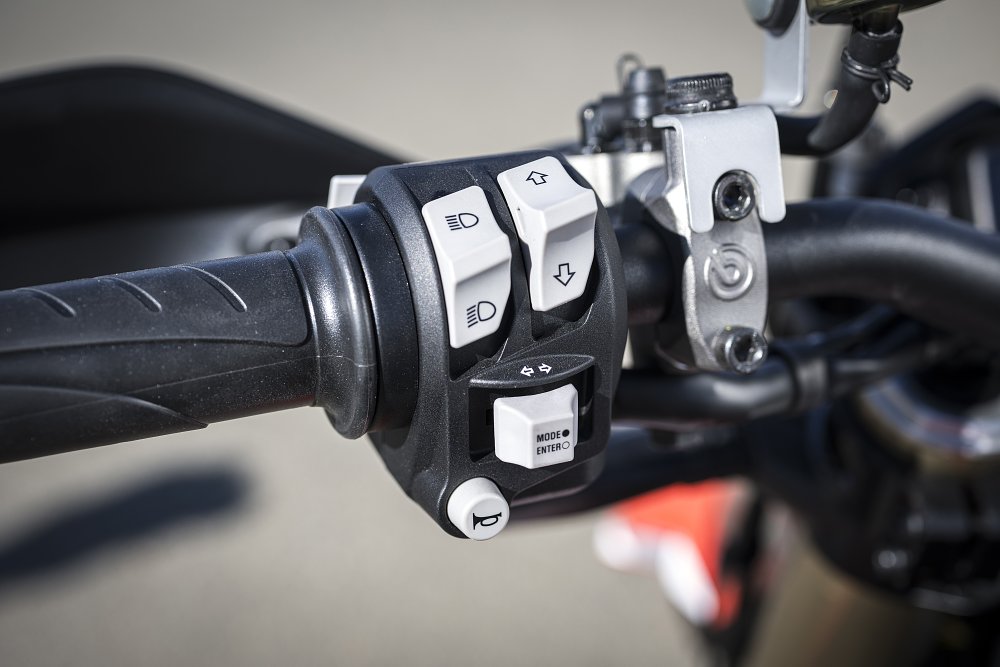
I immediately dove into testing as many of the electronic parameters as possible, to get a feel for the Hyper’s safety suite. Wheelie control and traction control are as expected — the lower the number the less intervention. Ducati went as far as to allow fairly tall wheelies with DWC turned down, very overtly trying to provide the fun of flirting with the balance point to those less comfortable with the idea.
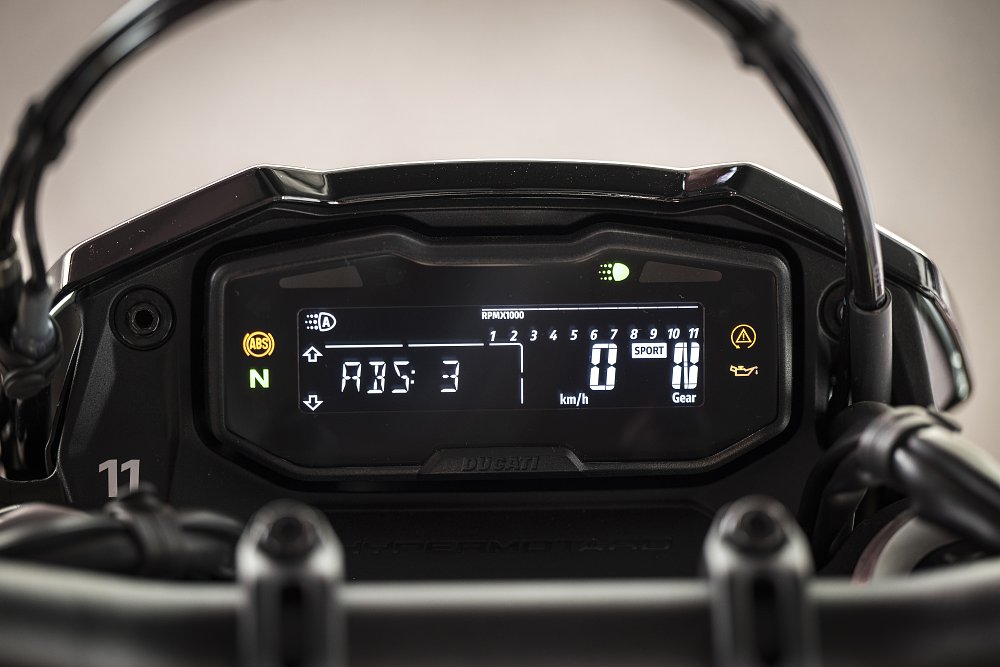
The anti-lock brake system involves an evolution of the “Slide by Brake” programming that was offered on the previous model, the Hypermotard 950. Basically, ABS can be set to an ultra conservative Level 4 that utilizes the full might of the IMU and does not allow the tires to slide or the rear wheel to come off the ground when braking. Or, you can use the free-wheelin’ Level 1, which offers basic ABS for the front brake (ignoring IMU data), letting the rear wheel lock and stoppies run rampant. The settings in between are the real challenge.
With Level 3 and 2 respectively, the Hyper 698 progressively loosens the reins and allows more slip from the rear tire during deceleration, therefore increasing the rider’s ability to look and feel more like a real supermoto hero. The theory is simple, but programming the system to monitor lean angle, brake pressure, and speed in a way that facilitates smooth and controlled corner entry, when the rider is probably in over their head, was a big task.
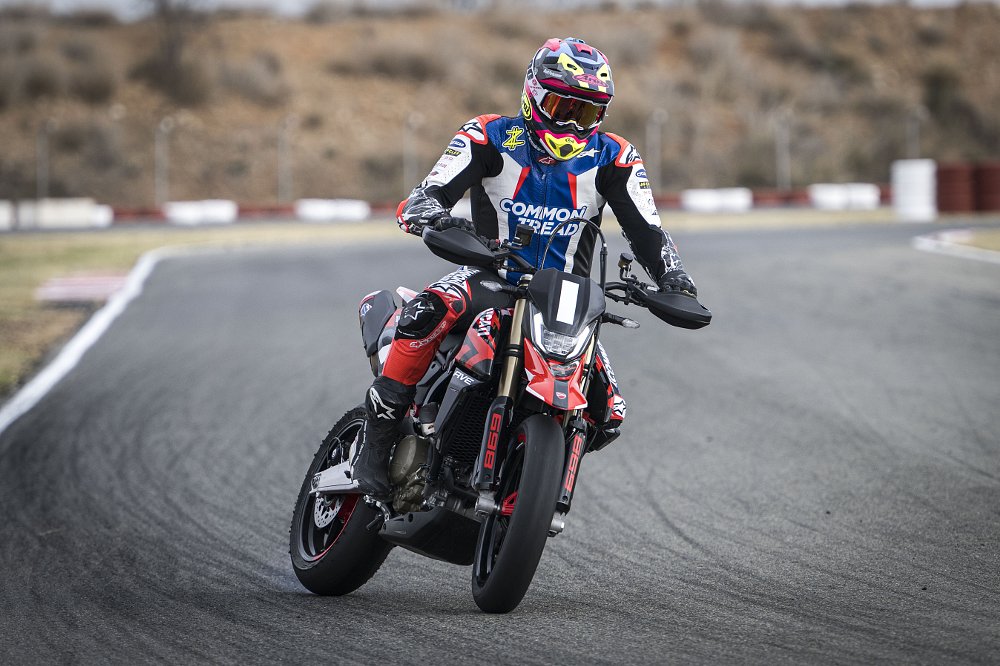
Ducati personnel were the first to admit that the system isn’t magic. The rider needs to understand basic supermoto principles, primarily braking hard enough with the front tire that the rear is free to slide. In practice I found it imperfect, but also useful. Level 3 lets the rear tire drift gently off line entering corners. It’s understandably conservative while being more lenient than on-road ABS systems typically are.
Set to Level 2, the bike is a different animal. Entering a corner at (my) maximum braking while tapping the quickshifter to drop a gear or two, I quickly got in the habit of just laying my right boot on the rear brake pedal and letting the electronic genie do the rest. With enough smoothness and consistency, the system offered me fairly extreme, but also worry free, slides as I dove into corners. In general the bike handled beautifully — extremely quick to change direction and plenty of stability in the middle of a corner. My only complaint was a bit of vagueness on the very edge of the tire, maybe an effect of the long fork or perhaps the limit of my riding ability.
Occasionally, ABS Level 2 frustrated me by not allowing much of a slide at all, and once in a while the rear wheel would snap sideways quicker than expected and give me a spook that made me miss my apex. Even if it’s less than perfect, I found myself enjoying ABS more than I ever have on a racetrack, and Ducati deserves credit for programming a motorcycle that gets so close to the edge of control, just for the sake of fun.
My final few sessions on the track were aboard the up-spec RVE version, in other words an even more hyper Hypermotard, with a $1,500 price bump to $14,495. With the standard suspension stiffened even more, the fork was raised through the triple clamps five millimeters to lower the front end and the bikes were equipped with the $3,000 aftermarket exhaust, which adds seven horsepower and unlocks an even more indulgent wheelie control setting. Yee-haw.
The RVE in this spec is remarkably capable. The engine in this state of tune finally feels as absurdly snappy and energetic as the chassis is agile. A single-cylinder, 300-something-pound sport machine that approaches $18,000 once you add the exhaust had better be engaging, and I can tell you the Hyper is definitely that. I rode as fast as I dared and all the while got passed like I was standing still by Ducati testers and professional racers in attendance. The performance ceiling for this bike, in this environment, is seriously high.
A mellower approach
To take a step back from the specific and precise goal of sliding into a corner trying to look like a MotoGP rider in training, the Hypermotard 698 seems like it will be a pretty agreeable street bike. I spent a few lazy laps riding as I might on public roads and there weren’t any ugly surprises.
The engine shudders noticeably below 4,000 rpm under load, as big singles will do, but engine speed at 65 mph was about 5,500 rpm and the twin counterbalancers in the bottom end of the Superquadro Mono seemed to be doing their job. I wouldn’t be surprised to see some vibes in the mirrors on the Hyper 698, though I didn’t get to try a bike equipped for the street.
The footpegs are high but the seat is even taller, so I don’t expect many complaints about leg room, and while wind protection is obviously terrible, being able to move around so freely on the seat will likely help. Some reviewers might complain that the suspension felt too soft for riding aggressively around a kart track, despite being fully adjustable. I disagree. I still had a riot at speed and I think the majority of miles that Hyper 698s log on the street will be more comfortable because of the cushier suspenders.
Ducati proudly pointed out that the compact, two-color dash is tucked neatly into the cockpit and doesn’t detract from the Hyper’s simple aesthetic. It’s also arguably too small for all of the menus and options that the bike has, and the weensy bar-type tachometer is almost useless from the saddle. Asked to pick a side, I’m with the Ducati PR team — the minimalistic approach suits the bike, and frankly I don’t need another huge, full-color screen in my life.
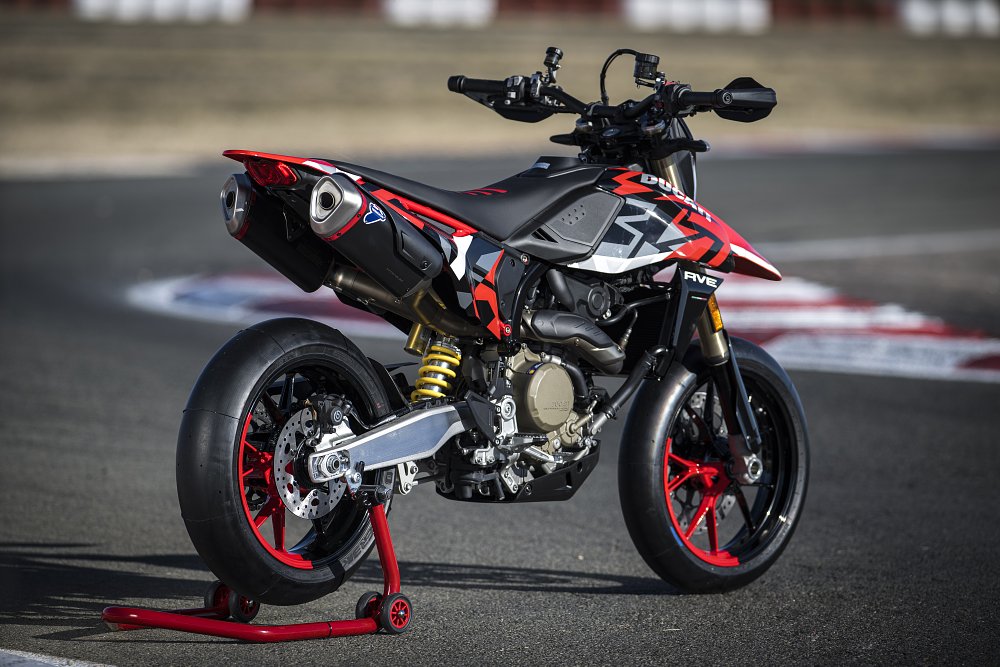
Anyone worried about the single front brake disc can give up on that right quick. The brakes are terrific, powerful and linear and everything else you would want, including adjustability of the radial-pull lever. That’s the story with the fit and finish in general, clean and tidy.
The Hypermotard 698 goes beyond being nicely finished, though. Helping riders approach the limits of the machine and their own abilities with ABS programming that's built into the suite of electronics is intriguing. Ducati poses it as having fun “with a parachute,” but it’s more than that. It’s bordering on rider education, baked into the machine from the factory. Setting aside the conflicted feelings brewing in my own heart, it is impressive and bold.
An orange elephant in the room
All of this talk about a radical new engine and claims of “record-breaking” performance and specifications got me wondering how it stacks up to the rest of the class. First, on paper. There isn’t a lot of competition in the high-end, supermoto-spec, single-cylinder marketplace, but there are a few very obvious ones — namely the KTM 690 SMC and its nearly identical siblings, Husqvarna’s 701 Supermoto and GasGas’s SM 700. I combed through specs for the Husky 701, for reasons that will become clear.
In some ways the Ducati is plainly ahead. The Hypermotard Mono’s 659 cc engine makes 77 claimed horsepower, three up on the 693 cc Husqvarna, in part because the Ducati revs to 10,250 rpm, a big step above the Husky’s 9,000-rpm redline. The Ducati also shaves more than an inch off the Husky’s 57.8-inch wheelbase and offers a slightly steeper steering-head angle, both of which Ducati marked as important traits for an agile and responsive supermoto.
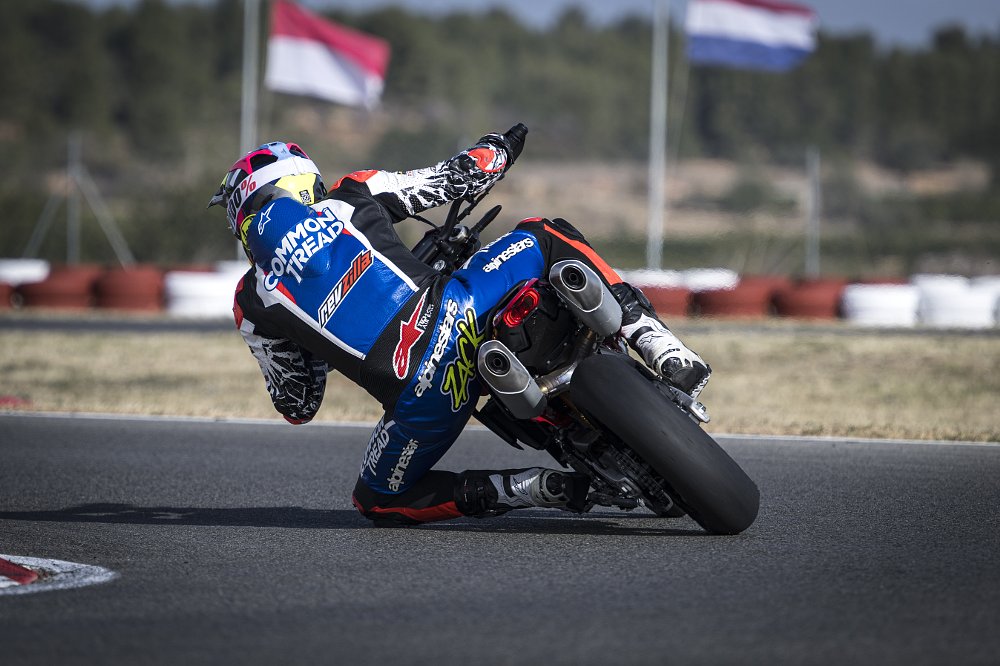
On the other hand, despite Ducati’s best efforts to cut fat from the engine, the Husky mill is about 2.5 pounds lighter (while claiming 17% more peak torque). With an empty gas tank the Hyper 698 weighs a claimed 333 pounds, about 10 more than the Husqvarna claims with no fuel, which also has a seat that is a shade lower and holds nearly an extra half gallon of fuel.
Upon landing back in Los Angeles, my Common Tread colleague Dustin tossed me the keys to his 2020 Husqvarna 701 Supermoto — a quick reality check for what I felt in Spain aboard the new Hyper 698. Perhaps no surprise, the Husky feels much more like an off-roader set up for the street. Intake noise dominates the overall sound of the bike and the engine seems to deliver most of its grunt down low, totally in line with a single-cylinder, off-road powerplant.
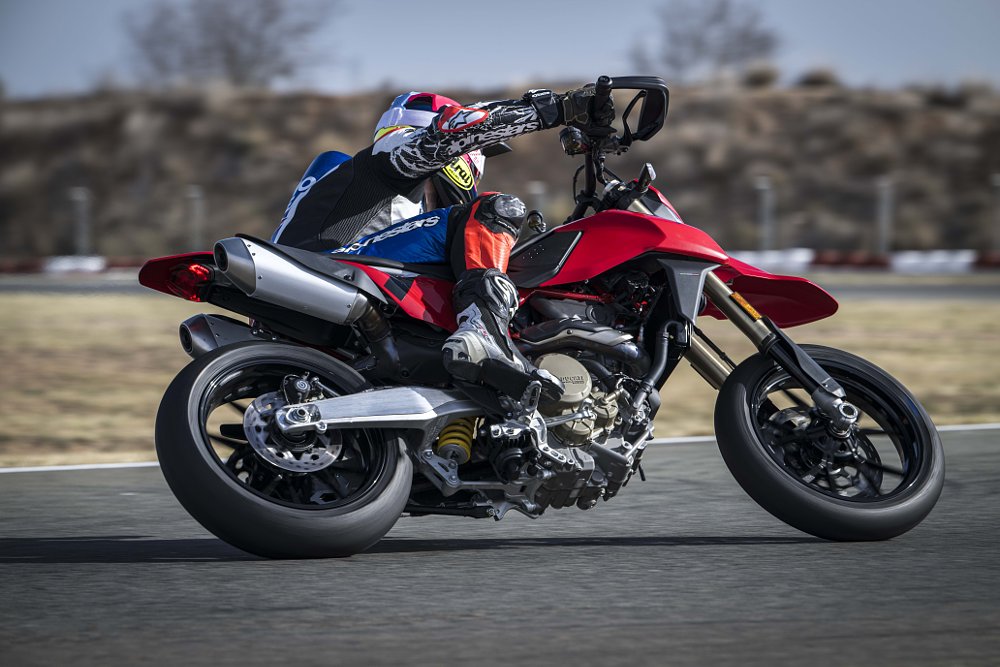
The ergonomics are surprisingly similar, with a long flat seat, though in my intra-continental back-to-back test I think the Ducati’s perch is softer. Mostly, the Husky feels especially spartan and raw. It’s lithe and small, and the dash is shockingly simple, as are the electronics. The quickshifter isn’t as smooth. The switchgear and buttons feel like they were engineered for some kind of military equipment, not a road-going motorcycle.
Simply put: it feels like a big dirt bike, through and through, probably because that's how it started. And that can be a good thing, depending on what you want, but considering the MSRP of the two bikes is practically identical, the Ducati gets a heavy nod for refinement. The Hypermotard 698 feels like a dirt bike when you sit on it, but riding and using it is a different story.
Who wants one?
From a performance standpoint, either riding like a hooligan or a reasonable person, I don’t have many complaints. The looks are a little bland, for my taste — it feels like a bike meant to be a statement should look like one. Aside from that, the new Hypernotard suffers only from being pointed and uncompromising, and maybe a little pricey. I don’t see any engineering misses. My biggest question swirls around what the bike is, facing off with what Ducati wants it to be.
The team behind the Hypermotard 698 surely had the KTM 690 family of machines in their sights, and by doing so the Italians have built what is arguably the sexiest and most sophisticated supermoto available today. So, can a bike be that as well as an entry point into motorcycling? Can a machine encapsulate, as the website suggests, the purity and elitism of tire-smoking performance alongside the laid-back energy of an iced-tea commercial?
Like I said, it’s a complex machine. If the Hyper 698 can be a meeting point of these two cultures, if it can somehow lure an untapped market into the joy of thumping around a city, or even a racetrack, that would be great. The good news is, most of the complexity is skin deep. At its core, the Hypermotard 698 is as simple and potent as supermotos have always been, and you’re likely to feel that in every ride.
| 2024 Ducati Hypermotard 698 Mono | |
|---|---|
| Price (MSRP) | $12,995 (base), $14,495 (RVE Edition) |
| Engine | 659 cc, liquid-cooled, four-valve, single |
|
Transmission, final drive |
Six-speed, chain |
| Claimed horsepower | 77.5 @ 9,750 rpm |
| Claimed torque | 46.4 foot-pounds @ 8,000 rpm |
| Frame | Tubular steel trellis |
| Front suspension | Marzocchi 45 mm fork, adjustable for spring preload, compression and rebound damping; 8.5 inches of travel |
| Rear suspension | Sachs shock, adjustable for spring preload, compression and rebound damping; 9.4 inches of travel |
| Front brake | Brembo M4.32 four-piston caliper, 330 mm disc with ABS |
| Rear brake | Brembo single-piston caliper, 245 mm disc with ABS |
| Rake, trail | 26.1 degrees, 4.2 inches |
| Wheelbase | 56.8 inches |
| Seat height | 35.6 inches |
| Fuel capacity | 3.0 gallons |
| Tires | Pirelli Diablo Rosso IV, 120/70 ZR17 front, 160/60 ZR 17 rear |
| Claimed weight | 333 pounds (no gas) |
| Available | February 2024 |
| Warranty | 24 months |
| More info | ducati.com |

 Membership
Membership


